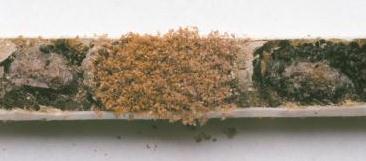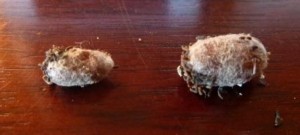Why Harvest Bee Cocoons?
People often ask why harvesting mason bee cocoons is important.
Here’s a helpful analogy? You wouldn’t get a new puppy, buy him a comfy pillow, and then put him in a dog house infested with fleas. If you did that your puppy would suffer, loose vitality, scratch endlessly, and can become very ill or worse. Instead, you would do whatever is needed to protect your puppy.

In the same way, mason bees have many natural enemy pests that claim countless numbers of bees each year.
The photo shows a cell filled with mites and mite poop. The orange is mostly droppings. The mites are numerous but they are somewhat clear to whitish colored. You will not find a bee larva in the cells with numerous mites. The mites either destroyed the bee egg or ate the bee larva food supply so the larva starved.
While the bees have few defenses against them, we can help save them from the agony of defeat.
How Nature Works
Here’s how it happens. In nature, wild mason bees find holes left behind by wood boring insects or look for hollow stems to use as nesting tubes. Pollen mites collect on the bee when foraging for pollen. While the female is building the cells inside the holes some mites drop off in the pollen pile.
The mites multiply rapidly numbering hundreds or thousands in a short time. The bee egg within those infested cells are killed. The mites are usually locked into the single cell due to the mud walls separating the bee larva.
In the spring, the emerging bee must break through the mud wall and crawl through the wall of mites where they immediately cling to the bee’s body. The blossoms and tree leaves get infested with mites that are scratched off by the bees. Other bees pick up the mites. When the bees enter a new nesting hole, the mite invasion starts over again.
What You Gain From Harvesting Cocoons
- Harvesting mason bee cocoons frees the bees from having to crawl through the mites in the spring. The generation that emerges is stronger and healthier.
- You are actually increasing bee populations and helping ensure the health of future generations.
- You can keep track of the total number of cocoons. If you set out additional bee houses your bee numbers and cocoons will increase dramically each year.

When you examine the cocoons you will immediately notice the male to female ratio (male cocoons are a third smaller as shown in the photo). The ratio should be about 50/50. Too many males means your tubes are too short.
(Photo courtesy of Dave Hunter)
- You can have an increase of fruit or flowers with the increase of pollinators.
- North American native bees excel at pollinating North American trees and plants.
- Refrigerating the cocoons keeps then in hibernation and allows you to put out the cocoons when you need them in the spring.
- Refrigeration avoids the often ill-timed fatal releases that can occur in unseasonably warm spring weather before the trees are in bloom. There must be a source of food for the emerging bees. Without pollen and nectar from blooms, the bees will quickly die.
- It’s fun and your children can learn about the life of bees.
- Many commercial growers and resellers will purchase your healthy bee cocoons above what you need for your own garden or orchard.
- You become an environmentally aware, socially responsible person seeking to advance the cause of native bees. Since most people don’t even know we have native bees, you will be the neighborhood native bee expert.
Other Methods of Protecting Your Bees
To prevent other pests from preying on the bee larva, gently remove the nesting boxes shortly after the bees stop flying. This is sometime around the first of May in most areas. Place the box in a net bag, i.e. Bee Guardian Net Bag. You can use hose stockings of you prefer.
Place the net bag in a well-ventilated corner of the garage. This keeps the parasitic wasps, carpet beetles, and other insects from entering the nests.
In the fall you can harvest the cocoons and place them in a small humidity box (plastic container with vent holes and a damp paper towel). Make sure the wet towel is not touching the cocoons.
Do not harvest the bees too early or they will be underdeveloped and die. November is a prime month for harvesting mason bee cocoons.
CLEANING YOUR MASON BEE COCOONS
Method One – Washing the Cocoons
This method involves washing the mason bee cocoons in a bleach and water solution. Don’t worry, the cocoons are tough and will not be hurt. This does not kill the mites, but washes them off. The mites are extremely hard to kill, even with bleach.
- Get a bowl of water and add a small amount of bleach to about a 5% solution.
- Place the cocoons in the bleach water for about 3 to 5 minutes stirring them around.
- Remove the cocoons and rinse them thoroughly with fresh water.
- Lightly pad them dry with a paper towel. Do not store them in the refrigerator wet.
- Do not use hot water or it may cause the larva to awake and think it is time to emerge. Use cold water and store in the refrigerator before they heat up to room temperature.
Method Two – Using sand to Clean Cocoons
This method was developed by Hutchings Bee Service, British Columbia.
- Get a mesh screen with small holes large enough to allow sand to flow through, but not the cocoons. Farm stores often have a variety of screens sizes. You can make a simple sifting box if you like.
- The most simple method is to form a cup with the mesh or lay the mesh flat over a bowl. Put the cocoons onto the mesh and carefully pour clean sand over the cocoons. The sand will brush off the mites as the sand passes over them. The mites are smaller than the grain of sand and pass into the bowl.
- Pour sand over the cocoons several times to ensure pollen mites are gone. You can reuse the sand in the catch bowl to clean the mason bee cocoons. However, once the cocoons are cleaned throw the sand away in a place some distance away from any bee pollen source.
After Cleaning Cocoons
After cleaning the mason bee cocoons, put the clean cocoons in a breathable sealed container and place them in the crisper drawer of the refrigerator. Place a damp paper towel in the container near the cocoons to provide humidity. Do not place the cocoons directly on top of the wet towel. Storing them in the refrigerator is the best method because you can keep them in hibernation until you are ready for them in the spring.
An important caution if storing cocoons in a non-heated garage during the winter:
A second option is to place the mason bee cocoons in a non-heated garage or shop building. If you experience several days of unseasonably warm weather, the heat may warm the cocoons enough to trigger an emergence. If that happens, but is followed by freezing weather, or if you have no blossoms yet, you will lose your bees. For this reason, it is better to keep them in a controlled environment.


